

England
1984-2001
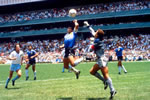 1984 brought a return to a more traditional look for England's kits with Umbro replacing Admiral and, as a welcome change, the team regularly qualified for the final stages of the major tournaments. High World Cup expectations were dashed by Maradona and the Hand of God in Mexico 1986, and by the Germans' superior ability in the penalty shoot-out in Italia '90.
1984 brought a return to a more traditional look for England's kits with Umbro replacing Admiral and, as a welcome change, the team regularly qualified for the final stages of the major tournaments. High World Cup expectations were dashed by Maradona and the Hand of God in Mexico 1986, and by the Germans' superior ability in the penalty shoot-out in Italia '90.
England's European Championship campaigns were catastrophic until Euro '96, held inEngland, ended by Germany in a penalty shoot-out.
Sources:
 1984-1987
1984-1987
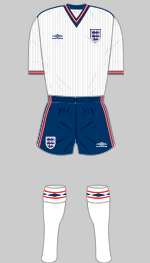
1984-1987
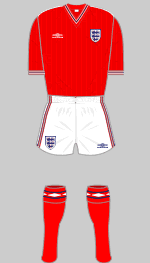
1984-1987 Change
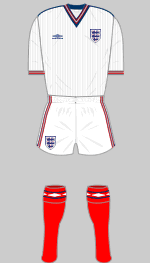
June 1984 Tour
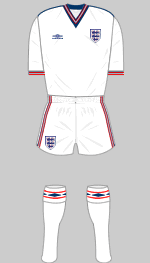
16 June 1985 v USA
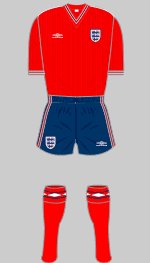
1985 16 October v Turkey
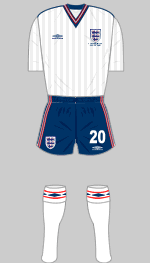
1986 World Cup Finals
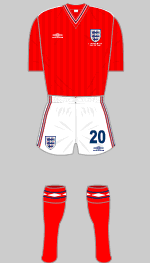
1986 WCF Change
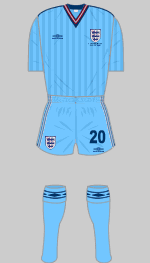
1986 WCF Third
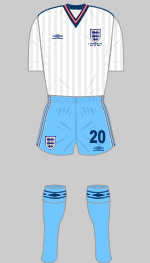
1986 WCF v Argentina

18 Feb 1987 v Spain
Designer: Umbro
In 1982 the Admiral sportswear company was declared bankrupt and although the brand name survived under new ownership, the England contract was not renewed after it lapsed at the end of 1983. Umbro, now renewed their relationship with the FA in a world where the commercial exploitation of replica kits was becoming increasingly important. In future, shirts would have a limited shelf-life and be replaced on a regular basis.
The new designs marked a return to tradition with the reintroduction of navy blue shorts: the white shirts first appeared at the Parc des Princes on 29 February 1984 while the red version made its debut on 13 June 1984 in the game with Uruguay in Montevideo. Both shirts featured subtle pinstripe woven into the fabric and the badge was worn on the shorts for the first time. All-white kits were used against Chile and Brazil on the 1984 summer tour.
The 1986 World Cup Finals were for the second time played in Mexico and as in 1966, England commissioned a special set of strips to be made from lightweight, ventilated fabric. The designs were identical to the normal kits apart from the lack of cuffs and the addition of bolder shadow stripes. A third kit in pale blue was included but not used (although the shorts and socks were paired with the white shirt for the quarter-final game with Argentina.
 1987-1989
1987-1989
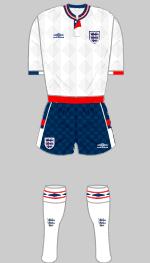
1987-1989

1987-1988 Change
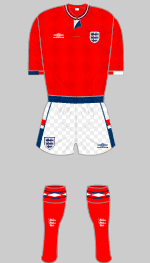
1988-1989 Change
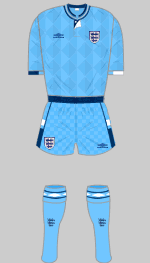
1987-1989 Third
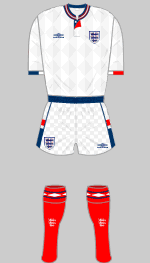
23 May 1989 v Chile
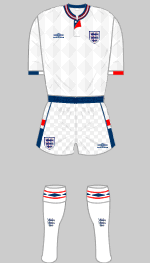
6 Sept 1989 v Sweden
Designer: Umbro
The new Umbro design featured every innovation that a modern playing kit of the period could conceivably include. A new artificial fabric called Tactel was used throughout, which, it was claimed would keep the player comfortable regardless of climate. A subtle shadow pattern was woven into the shirt fabric partly as a fashion feature but also as a way to discourage counterfeits. The collar was a fashionable crew neck fastened with a stud and the cuffs were made in a novel block pattern (at least on the short sleeved version - long sleeved shirts were produced with red and blue rings at the cuff). The shorts had a chequered pattern woven iinto the fabric and a contrasting waist band. The finishing touch was the addition of the three lions motif on the stockings.
The red change kit mirrored the white and navy outfit once again so that all the different elements were interchangeable. Curiously this set was not introduced until 24 May 1988, the previous change kit being used twice in 1987-88 (v West Germany 9 Sept 1987 and v Israel 17 Feb 1988). The new version was unveiled at Wembley in a game with Colombia and was used only four times.
A third kit in pale blue was produced but, like its predecessor, never used.
 1990-1992
1990-1992
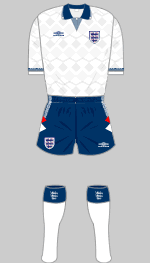
1990-1992
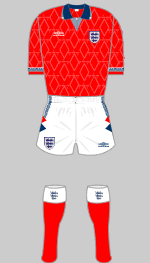
1990-1993 Change
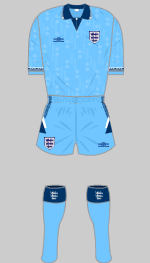
1990-1991 Third
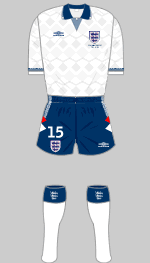
1990 World Cup Finals
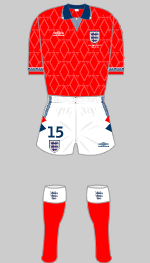
WCF 1990 Change Kit
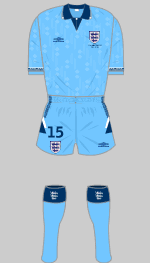
WCF 1990 Third Kit
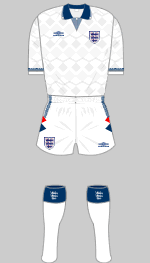
June 1991 Pacific Tour
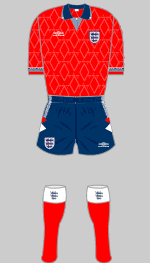
June 1991 Pacific Tour v New Zealand
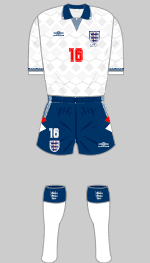
1992 European Championship
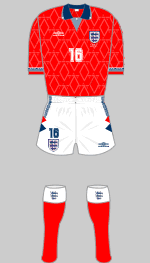
EC 1992 Change
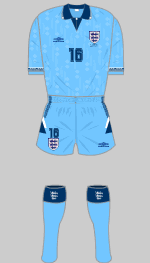
EC 1992 Third
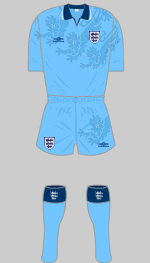
1992 Third Kit
Designer: Umbro
The new designs introduced in the run up to the Italia '90 World Cup were clearly intended to cement the identities of Umbro and the English national team together: the trim on the sleeves, collar and shorts of these new kits was made up of Umbro's double diamond logo while abstract diamonds were incorporated into the weave of the white and red shirts. For the competition itself
"FIFA WORLD CUP ITALIA '90" appeared below the badge while squad numbers were worn on the shorts. England wore their white and navy strip throughout the tournament: the red and blue alternatives did not appear.
As in previous years the elements of the white and red kits were interchageable but oddly these were only used during the Pacific tour of 1991 (England wore red tops with navy shorts in New Zealand on 3 June and all-white against Australia (1 June 1991) and Malaysia (12 June). The pale blue outfit had one airing, a European Championship qualifier in Turkey on 1 May 1991, the first time a third kit had been used since 1970.
The kits were also used in the 1992 European Championships held in Sweden. Once again a special set was produced, with "EURO 92 SWEDEN" written below the badge but only the white and navy outfit was used. For the first time squad numbers appeared on the front of players' shirts and, players' names were printed on the back of their shirts, above the numbers. The white kit was retired after the game against Turkey at Wembley on 18 November 1992.
An alternate version of the pale-blue third kit was used in twice in 1992 (25 March v Czechoslovakia and 9 September v Spain) featuring the three lions embossed into the fabric. This was the last time England used a third kit.
 1993-1994
1993-1994
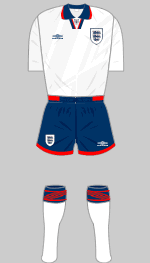
1993-1994
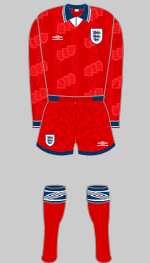
1994 Change
Designer: Umbro
A modified crest was introduced in 1993, with a white margin surrounding the three lions motif. This appeared for the first time on 17 February 1993 against San Marino at Wembley on the new white shirt. This proved to be the most short-lived of all England outfits, and was used for the last time on 16 November 1994.
England did not use a change kit in 1993 but on 17 May 1994 they unveiled a new red strip (officially described as "wine red") in a 5-0 win over Greece at Wembley. The FA crest as well as Umbro diamonds were woven into the fabric of the shirts.
 1995-1996
1995-1996
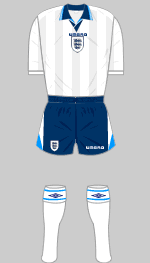
1995-1996

1995 Change
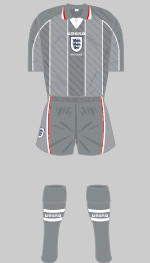
1996 Change
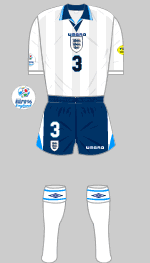
1996 Euro '96
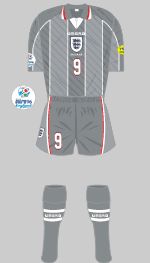
1996 Euro '96 Change
Designer: Umbro
The wine-red kit made two more appearances in 1995: on 15 February in Dublin (abandoned due to crowd disorder) and then against Brazil at Wembley in May.
The new white and navy kit was introduced on 3 June 1995 at Wembley (v Uruguay) and featured turquoise flashes. For the Euro '96 tournament, held in England, sleeves patches were worn for the first time. Squad numbers were sewn onto the front of shirts as well as shorts, which became a permanent feature. The new change kit was described by the FA as "indigo" but to everyone else it was a really dull grey. Unveiled on 27 March at Wembley, this kit is best remembered as being worn in the Euro '96 semi-final when England were eliminated by Germany on penalties. It was worn once more the following November in Georgia and was then retired.
< England 1960-1983 |
Home Nations Index Page |
England 1997-2010


 1984 brought a return to a more traditional look for England's kits with Umbro replacing Admiral and, as a welcome change, the team regularly qualified for the final stages of the major tournaments. High World Cup expectations were dashed by Maradona and the Hand of God in Mexico 1986, and by the Germans' superior ability in the penalty shoot-out in Italia '90.
1984 brought a return to a more traditional look for England's kits with Umbro replacing Admiral and, as a welcome change, the team regularly qualified for the final stages of the major tournaments. High World Cup expectations were dashed by Maradona and the Hand of God in Mexico 1986, and by the Germans' superior ability in the penalty shoot-out in Italia '90.






























